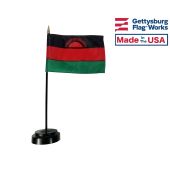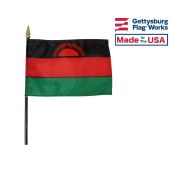Flag of Malawi

Flag of Malawi
The nation of Malawi was born in the aftermath of the second world war, when it and many other nations gained their independence from the British Empire. The modern flag of Malawi was designed at the same time, but it was not the first flag to represent Malawi, nor has the design remained completely consistent since the nation first became independent.
The current flag of Malawi was adopted on 29 July 2010, after the Democratic Progressive Party-led government had proposed a new flag. The stripes were altered from the previous flag to match the original Pan-African Flag layout, with the red stripe at the top, the black stripe in middle, and the green stripe at the bottom. The rising sun at the flag's top was replaced with a full, centred white sun representing the economic progress Malawi has made since becoming independent. The opposition United Democratic Front is challenging the flag change in court. The flag was endorsed by the President of Malawi, Bingu wa Mutharika, who approved the flag change on 29 July 2010.
- Capital of Malawi: Lilongwe
- Area of Malawi: 94,080 sq. km
- Languages used in Malawi: Chichewa (official), Chinyanja, Chiyao, Chitumbuka, Chisena, Chilomwe, Chitonga
- Religions in Malawi: Christian, Muslim
Colors and Symbolism of Flag of Malawi
The flag of Malawi is a horizontal triband of black, red, and green that displays a red sun rising from the upper black band. The black band represents the native people of Malawi and the rest of Africa, the red band represents the blood shed during Malawi's attempts to gain independence, and the green band represents nature. The rising sun is a symbol of hope for the future and the spread of independent rule to the other nations of Africa that were still European colonies.
History of the Flag of Malawi
Several different flags represented Malawi during its time as a British colony. They were all British blue ensigns with the Union Jack in the canton that bore the colony's seal, but the seal changed every time that Malawi's colony administration was altered. It began as the British Central African Protectorate, which was represented by a bush on three diagonal bands of yellow, white, and black. It gained a new seal when it became Nyasaland in 1914. That seal featured a leopard standing on top of a mountain, which would represent the nation until it gained its independence in 1964.
Nyasaland became the nation of Malawi when it became independent from Britain, and it adopted the new flag to represent itself at the same time that it chose a new name. It adopted the design that is still in use, which drew heavily on the Pan-African flag, although it displayed the colors in a different order. Malawi briefly adopted a different flag in 2010. The new design rearranged the colors to match those of the Pan-African flag and replaced the rising sun in the black band with a white sun in the center. Many of Malawi's citizens disliked the design, and the nation reverted to its previous flag in 2012.


